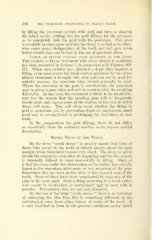Page 462 - My FlipBook
P. 462
210 THE TECHNICAL PKOCEDUEES IN FILLING TEETH.
by filling the proximal cavities with gold and then so shaping
the labial cavity, cutting into the gold fillings for the purpose,
as to completely hide the gold with the porcelain. This plan
is available in some cases in which the decay is so bad as to other-
wise cause great disfiguration of the teeth and will give much
better results than can be had by the use of porcelain alone.
Labial or buccal cavities with recession of the gums.
This subject, so far as treatment with silver nitrate is available,
has been presented in Volume I, in connection with Figures 168-
171. "V^Tien such cavities have attained a depth that requires a
filling, or in cases where the black surface produced by the silver
nitrate treatment is brought into view and can not be used for
esthetic reasons, the porcelain inlay should generally be used.
Where the recession of the gum is considerable, the porcelain
may be given a gum color and will do much to hide the resulting
deformity. In any case, the treatment is likely to be unsatisfac-
tory for the reason that the receding gum will so frequently
recede more and expose more of the surface of the root in which
decay will recur. This will often occur whether the filling be
gold or porcelain, yet, by preventing depth of penetration, much
good may be accomplished in prolonging the usefulness of such
teeth.
In the preparation for gold fillings, these do not differ
so essentially from the ordinary cavities as to require special
description.
Senile Decay op the Teeth.
By the term "senile decay" is usually meant that form of
decay that occurs in the teeth of elderly people about the gum
margins when these have become very short. The decay is apt to
invade the cementum soon after its beginning and for this reason
is unusually difficult to treat successfully by filling. Much of
it that has come under the observation of the author has actually
begun in the cementum after more or less recession of the gum.
Sometimes this has been on the sides of the exposed root of the
tooth. Some of these have been complicated by exposure of the
pulp in the root canal. Such a thing occurring in a tooth other-
wise useful in mastication, is particularly ugly to meet with in
practice. Fortunately, they are not very frequent.
By the use of the term "senile decay," there is no intention
of conveying the idea that this is something different in the
pathological sense from other classes of caries of the teeth. It
is only modified in form by the general conditions under which


